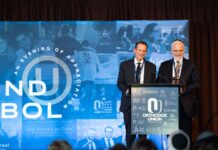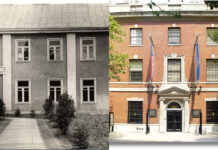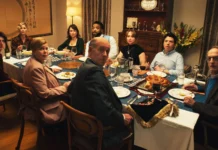- Neri Sotan, CEO of The Kibbutz Movement Rehabilitation Fund, talked to The Jewish Web Site on the Israeli Government Failures, Urgent Needs of Northern Kibbutzim and rehabilitation costs. According to Governmental assessments, rebuilding of the north will cost over 9 billion shekels, but so far, only 2.2 billion shekels have been allocated.
- Neri Shotan: “The Jewish communities worldwide have stood with us from the very beginning, and without their support, we couldn’t have managed.”
October 7th, 2023
It all began at 6:29 a.m. At 10:34 a.m. the Kibbutz Movement leadership learnt that Ofir Libstein, head of the Sha’ar HaNegev Regional Council, was killed in battle. At that moment, it became clear—this was unlike anything they had ever faced before. By 6:00 p.m. the Kibbutz Movement Rehabilitation Fund was founded. In those first hours of chaos, they called it what it truly was: The Kibbutz Movement Emergency System.
“October 7th was a total failure, Troops were diverted to the West Bank due to pressure from extremist politicians, leaving the south exposed ” says Neri Shotan, then Head of the Political Department of the Kibbutz Movement and today CEO of The Kibbutz Movement Rehabilitation Fund.
In our conversation, Shotan openly shares who he believes is responsible for October 7th attack and describes the current state of the kibbutzim and community members, a year and a half after the attack. Later in the discussion, Neri outlines the immense costs of rehabilitation that the State of Israel must face and highlights the role of the Jewish Diaspora and the significance of diaspora philanthropy in this context.
Who do you think is responsible?
“Everybody is responsible” Shotan replies. “The army, the government, the police, all of them. I think everyone messed up. But today IDF and Shabak took responsibility. The only one who didn’t take any responsibility is Prime Minister Bejamin Netanyahu. He hasn’t been to Nir Oz yet, the ground zero of Israel. I’m also certain that if we, the Kibbutz members, were politically right-wing, the government’s response and the rehabilitation of the Kibbutzim would have been very different today”.
Shotan reinforces his assessment that the rehabilitation of the kibbutzim would have been carried out differently had the kibbutz members held right-wing views by saying that “On October 7th there were rumors and even plans to replace the Kibbutzim with religious settlements, some extremist right-wing members of parliament referred to the situation as a “miracle” because it opened the possibility to return to Gaza and rebuild Gush Katif”.
*The numbers of October 7th*
On that black Saturday, over 30,000 members from 26 southern Kibbutzim were hit hard, and Shotan, realized they were on their own. “The government systems collapsed,” he says. “I drove to Sha’ar HaNegev and just started helping, people needed clothes, kids’ shoes, laundry, even temporary burials.”
In the following days Shotan personally called the Interior Minister to issue new IDs for evacuees who had fled without wallets, so they could access banks and basic services. ” We brought special units to the evacuation areas to produce new IDs. So, that was the situation then.” says Shotan.
*Q*How many kibbutz members did the movement assist in total?
“By October 8th, in addition to the 26 kibbutzim in the south, 19 Kibbutzim from the north were also evacuated, so together over 50,000 people, both from the Kibbutzim and surrounding cities, were hosted in Kibbutzim across the central district. In my own Kibbutz, Shefaim, we hosted about 500 people from Kfar Aza for over a year, and 50 families are still here”.
Other harsh numbers of that day include of 300 Kibbutz members that were killed. 150 hostages out of 259 were Kibbutz members. 47 of them are still in captivity. In Nir Oz, 25% of the Kibbutz members were killed or abducted, and in Be’eri More than 100 Kibbutz members were killed. Kfar Aza, 64 Kibbutz members were killed, and 19 were abducted.
*Situation at the Kibbutzim now*
A year and a half after the October 7th attack, parts of the rehabilitation process have yet to began. The situation of the northern Kibbutzim—whose residents were evacuated starting October 8th due to Hezbollah’s attacks from Lebanon and who suffered significant damage throughout the war—is also stagnating.
“Some Kibbutzim along the southern border have started returning home, but 10 are still unable to do so. Rebuilding will take time, and the government is focusing on restoring the most damaged buildings. Meanwhile, Kibbutzim like Kfar Aza, Nir Oz, Be’eri, Nirim, and Holit are temporarily relocated”.
“On the northern border, 18 of 19 Kibbutzim started to get back to their homes in three waves, The first one took place few weeks ago, the second one will be after Pesach, and the third will be before the academic year. Only Manara won’t be able to get back for six months or more, and even though they will get back to their Kibbutz, it will be in temporary houses, like caravans, because 117 of 157 buildings in the Kibbutz were hit by Hezbollah.”
In addition to that, over 1,000 people in the Upper Galilee are waiting for mental health treatment. In the elementary school of Kibbutz Sasa on the northern border, they have almost 200 pupils and only one safe room. “So this is the situation now, the need is urgent” Shotan concludes.
*Q*Are Kibbutzim like Nir Oz and Be’eri planning to rebuild and return?
“Its very difficult. While the kibbutz will eventually recover, not all members will return. We must care for everyone, both those coming back and those who won’t. New residents will come to live in the kibbutzim, and Nir Oz will flourish again. Currently, only six houses in the Kibbutz are livable, so rebuilding will take time – it’s not just about restoring, but building from scratch”.
*Q*In the same place?
“It will be in the same place, but it won’t be the same Kibbutz. we understand the planning needs to be different. Most of the neighborhoods will be relocated farther from the Gaza Strip, rather than staying on the western side. It will be a new beginning, for a stronger and better Kibbutz, and we’ll make it work.”
*Q*What is happening to the people displaced from the kibbutzim?
“Most of the Kibbutzim in the south, even those unable to return immediately, are relocating to nearby areas. For example, Ruhama is about 30 minutes from Kfar Aza, and Hatzerim is the same distance from Be’eri, so people can return to their work in those regions. However, many are in a difficult mental state and cannot return to their homes. We are particularly concerned about the elderly members of the Kibbutzim, as we’ve seen a rise in deaths among them. This is a growing concern”.
*Rehabilitation will cost Billions*
While the government is starting to address this, especially in the south with the Tkuma program, the governmental agency that’s responsible to the rebuilding of that area, the northern border remains neglected with no similar support in place.
*Q*How is Tkuma doing in the south?
“They have budgets, and they have the ability to give budgets to the Kibbutzim and cities around the Gaza envelope. But in the northern border, there is no Tkuma, there is no governmental agency that is responsible to the rebuilding of the northern border. So there are lots of agencies and governmental offices, but there is no budget or not enough budget.”
Shotan’s main message is that “we need the money now, not in six months or a year. People are already returning to homes in the north, and those in the south need to rebuild. We must support community resilience after over a year and a half of displacement, and we need to restore educational systems, both formal and non-formal.”
*Q*And how much will it cost?
For Nir Oz for example, it will take three to four years to rebuild the assessment for rebuilding Nir Oz is over $150 million”.
“In the north the situation is extremely challenging, and it’s important for people to understand the gravity of it. Manara will cost more than 100 billion dollars to rebuild. The government’s assessment is that rebuilding of the north will cost over 9 billion shekels, but so far, only 2.2 billion shekels have been allocated. This gap is enormous. There are ongoing negotiations with the government regarding funding, and we hope they will provide enough to rebuild the Kibbutzim. If not, we will turn to philanthropy.”
*Q*Who is responsible for rebuilding the Kibbutzim?
“It’s the government’s responsibility to build it. But we know that we will need the communities around the world, the federations and good Jewish people to help us to rebuild those communities. It will take time, but they will flourish”.
The Jewish communities worldwide have stood with the Kibbutzim from the very beginning. “Without their support, we couldn’t have managed—especially when the government was not there for us” Says Shotan. “Jewish philanthropy, NGOs, and Israeli civil society have been essential in this effort from the beginning. But now most of them are in a strategic assessment on how they want to cut the money from now on. The Kibbutzimg will get stronger, they will be better. But we can’t do it alone.”
*Philanthropy is Essential*
*Q*What can the diaspora do to help?
“The American diaspora has been crucial in pressuring the U.S. government for a ceasefire and the return of hostages, and that pressure must continue. Rebuilding the Kibbutzim and surrounding cities is the government’s responsibility, but there are areas—like education, community resilience, and memorializing October 7th—where the government can’t fully step in. That’s where Jewish philanthropy is essential”.
Our fund is strictly dedicated to rebuilding the Kibbutzim in the north and south, and we need global Jewish support. The government will contribute, but it won’t be enough. To rebuild these communities stronger and more resilient, we need philanthropic help. Since October 16th, we’ve built a rehabilitation fund, knowing it will take time and significant resources. My sole mission is to rebuild these 41 Kibbutzim, and the support we’ve received from around the world gives me hope that we will succeed.
*Q*How can we mobilize the support of Latin American Jews, especially from Argentina and Mexico, to help rebuild the Kibbutzim?
Despite many Latin Americans on the kibbutzim, most donations come from America and Europe, not Latin America. I hope this changes, and that Latin American Jews, particularly from Mexico, will step up to support us. Nir Oz, Nir Itzhak, Ein HaShlosha, and a few other kibbutzim are home to many Latin American Jewish members.
*Q*Do people still see Kibbutzim as essential? What is their role now, and why are they so important for Israel?
“There is a famous metaphor that if you, turn off the lights all over Israel and only light up the kibbutzim, you will see the country’s borders. Kibbutzim along the borders, like Nir Oz, Nirim, Ein HaShlosha, and Kerem Shalom, have always been Israel’s guardians, embodying the Zionist way of securing its borders. This remains the only way to protect them, whether at the western, eastern, or northern borders.”
“After October 7th, Israeli society now better understands their importance. A year earlier, kibbutzim were scapegoated in the judicial overhaul debate, with extremists even blocking their gates. Today, most of Israeli society recognizes their value—it’s a matter of PR, but the importance of the kibbutzim is clear.”
Shotan, a devoted admirer of Bruce Springsteen, concludes the interview with a heartfelt quote: “As Bruce Springsteen said, it takes a leap of faith to move forward. I truly believe that. These are dark times for Israel, and the solidarity of Jewish communities worldwide is essential. It’s what keeps us from feeling alone. This is about faith, about shared responsibility. We are deeply grateful to those who stand with us, hand in hand.”
*The Kibbutz Movement Rehabilitation Fund* (link to site)
In response to the devastation of October 7th, the Kibbutz Movement established the Kibbutz Movement Rehabilitation Fund. This dedicated initiative addresses the urgent and long-term needs of kibbutzim that were evacuated or damaged in the attacks and the subsequent Swords of Iron War. The Fund provides immediate assistance, evaluates long-term recovery strategies, and supports rebuilding efforts. Additionally, it is developing an up-to-date information center to coordinate rehabilitation efforts. By facilitating reconstruction and community recovery, the Fund aims to ensure that displaced kibbutzim can return as thriving, resilient communities.




































